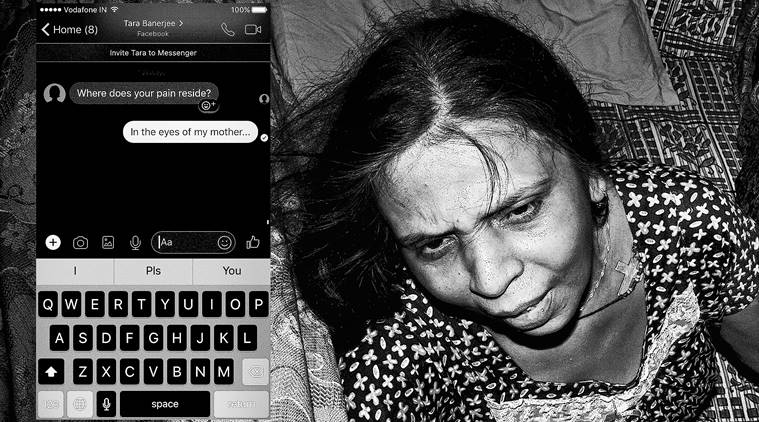Hanging on a Thread
Chandan Gomes weaves a discussion around loneliness and online relationships using his photographs at the prestigious Rencontres d’Arles festival in France

The photo of a distraught woman alongside conversations on pain highlights the social vacuum of a virtual world; another exhibit from the show (Chandan Gomes/PHOTOINK)
When New Delhi-based photographer Chandan Gomes initiated a conversation with Tara Banerjee, an unknown person whose friend request he accepted on Facebookin 2016 after seeing a list of 25 friends they had in common, he began with the mundane drill that people follow online on social networking and dating sites. “Tell me about yourself Tara”, he enquired from the user with no display picture, to which he was handed a rib-tickling response from the other end.
“I like to stalk gullible photographers online and then wreak havoc in their lives and relationships,” she said. Gomes was left with a thought worth pondering upon: “I am lonely and so are you”. The resulting conversations and its screenshots together form the crux of Gomes’ installation ‘People You May Know’, comprising 36 archival prints, and is the only Indian entrant at the prestigious photo festival Rencontres d’Arles in the small town of Arles in the south of France. Nominated by gallerist Devika Daulet-Singh, founder of PHOTOINK, for the New Discovery Award at the festival, Gomes was chosen as one among 10 artists from across the globe who could hold their solo exhibitions at the venue.
The photo novella, as Gomes terms it, is pasted on a wall and includes his photographs of pine trees interspersed against picturesque mountains, of a woman overlooking the sea to hint at what Banerjee might look like, and film stills from In the Mood for Love (2000) and Eternal Sunshine of a Spotless Mind (2004) that have been used as photo montages to create the setting for the brewing online romance. A quick glance at the conversations reveals Gomes’ confession to the unknown stranger, about his mother’s struggles with a memory disorder and how he grappled with its repercussions. One fine day, Tara asks him, “Where does pain reside?”, to which Gomes lends a heartwarming reply: “In the eyes of my mother”. The photo of a distraught elderly woman rests beside the screenshot of this conversation.
Till date, Gomes hasn’t met Banerjee — a deliberate choice — but has looked around for her at places she visits, be it Hauz Khas Village or a rock festival at the Purana Qila, to keep his conversations going. The main aim of his latest project is to raise questions. “What does identity mean during these times of social and virtual media? What does intimacy mean? Where does memory reside in the virtual world? What does it mean to build a memory of someone you don’t know in real life but only virtually?” he says, “The project addresses notions of identity, intimacy, memory and sexuality.”
Gomes was thrilled at the idea of archiving something that was intangible in ‘People You May Know’. The title of the exhibit is a play on Facebook’s friend suggestion feed. “If someday let’s say Facebook crashes or gets deleted then everything else will crash. There will be no proof or empirical evidence left of our innumerable online conversations. So how do you create a fact out of something so intangible. The idea of my latest photographs came from that. I wanted to make it physical. For me, these are letters that I am collecting from the last two years because in these times no one writes letters to each other,” he says about his collage of photographs and screenshots of conversations with Banerjee.
Gomes’ photo book in 2015 titled This World of Dew followed a similar premise of formulation, as he went about clicking photographs of mountains in Ladakh, Himachal Pradesh and Uttarakhand that bore an eerie resemblance to the mountain drawings of an ailing 12-year-old girl named Aini Haseena Bano, who left behind her sketchbook at a hospice in Jaipur. The discovery of the sketchbook and Gomes’ attempt to find her led him to visit her grave in Baran later.
Gomes reveals how Banerjee was a cure for his loneliness. The photograph of a film still from In the Mood for Love where a young woman rests her head on her lover’s shoulder, in the back of a taxi, provides a clue. “She delved into me like no one else ever has. We talked, talked and talked; I grew silent outside this virtual world. But I knew I was happy after a long time,” he confesses on the wall.
Gomes reveals how Banerjee was a cure for his loneliness. The photograph of a film still from In the Mood for Love where a young woman rests her head on her lover’s shoulder, in the back of a taxi, provides a clue. “She delved into me like no one else ever has. We talked, talked and talked; I grew silent outside this virtual world. But I knew I was happy after a long time,” he confesses on the wall.
The illusion existing in current times because of the onslaught of online platforms becomes more evident through Gomes’ exhibit. “Connectivity makes us feel that we live in a world where there is a lot of communication. But I think that is more of an illusion. That could be one reason why we gravitate towards strangers online. Everyone must have had experiences where they confided into strangers because anonymity gives you that breathing space. It saves us from being judged. That is one fear we have of being judged and that is why we put in so much effort to build our identity in the virtual world.”
For all the latest Lifestyle News, download Indian Express App






















 Another exhibit from the show (Chandan Gomes/PHOTOINK)
Another exhibit from the show (Chandan Gomes/PHOTOINK)
No hay comentarios:
Publicar un comentario